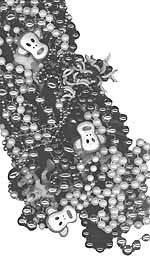 |
Mardi
Gras Madness Mardi Gras in New Orleans is often thought of as a place for drinking and partying. However, the history and meaning behind Mardi Gras is sometimes forgotten in all the festivities. Mardi Gras celebrations in New Orleans date back to the 17th century, when the city was founded by Jean Baptiste LeMoyne and Pierre LeMoyne, according to InsideNewOrleans.com. The explorers brought the tradition over from France where it had been celebrated since the Middle Ages.
In the 1840s, there was so much disorder associated with Mardi Gras that the celebration was almost banned completely. Mardi Gras was saved by a group, “The Mystick Krewe of Comus.” The members held the first New Orleans Carnival parade on the evening of Mardi Gras in 1857. Since then, other “krewes” groups who either start a new parade or put a float in an existing parade, have sprung up and the tradition has been carried on. For most people, the Mardi Gras experience is fun and something they never forget. It is an exciting time for both residents of New Orleans and tourists from all over the country, said Brad Thompson, a sophomore radio-TV-film major from New Orleans. “The weeks before Mardi Gras and that day are total insanity,” Thompson said. Brooks Zitzmann, a junior nursing and biology major who lives in New Orleans, said the daytime parades are more family-oriented than the nighttime parades. “There are two completely different atmospheres between the day and night parades,” she said. “The nighttime parades are generally more rowdy than the daytime parades.” Zitzmann said flashing occurs often at night parades and is now illegal. However, police have a hard time enforcing the rule, she said. Among the floats and marching bands in the parades, celebrities can also be found in the streets during Mardi Gras. Britney Spears was in a parade two years ago, and Whoopi Goldberg has also been spotted taking in the sights, Zitzmann said. During Mardi Gras, shops open that carry only goods that are useful during the parties and parades. For example, Mardi Gras World carries everything a person might need to celebrate, from beads to masks, Thompson said. Not everyone enjoys Mardi Gras though, both Thompson and Zitzmann said. Melissa Nabors,
a junior political science major, said, “I had to throw my
shoes away after walking down Bourbon Street. There was more alcohol
on the street than was being consumed.” After Mardi Gras is over, the clean-up takes over the streets. “One of the ways to count how many people were at the celebration is to measure the trash,” said Allison Russell, a sophomore graphic design major from New Orleans. However like
it or not, Thompson said a visit to New Orleans during Mardi Gras
is a must. Meredith
Smith |
|||
|
TCU Daily Skiff © 2002 |
||||


